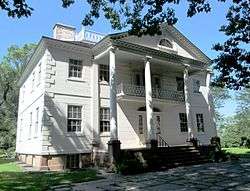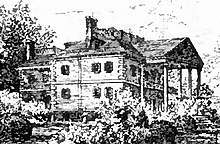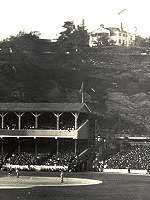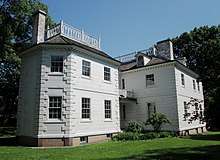Morris–Jumel Mansion
The Morris–Jumel Mansion or Morris House (also known as the Roger and Mary Philipse Morris House, "Mount Morris"[2] and other similar names) is a Federal style museum home in northern Manhattan with mid-eighteenth century roots. It was built in 1765 by Roger Morris, a British military officer,[2] and served as a headquarters for both sides in the American Revolution.
Morris–Jumel Mansion | |
 (2014) | |
 Morris–Jumel Mansion | |
| Location | 65 Jumel Terrace in Roger Morris Park, bounded by W. 160 St., Jumel Terr., W. 162 St. & Edgecombe Ave. Washington Heights, Manhattan New York City |
|---|---|
| Coordinates | 40°50′04″N 73°56′19″W |
| Built | 1765,[1] remodeled c.1810[2] |
| Architectural style | Palladian, Georgian, and Federal |
| Part of | Jumel Terrace Historic District (ID73001220) |
| NRHP reference No. | 66000545[1] |
| Significant dates | |
| Added to NRHP | October 15, 1966[1] |
| Designated NHL | January 20, 1961[3] |
| Designated CP | April3, 1973 |
| Designated NYCL | exterior: July 12, 1967 interior: May 27, 1975 |
Located at 65 Jumel Terrace,[4] in Roger Morris Park in the Washington Heights neighborhood of Manhattan, New York City, it is the oldest house in the borough. The home and grounds were purchased as a museum home in 1903 and declared a National Historic Landmark in 1961.[3][5] The exterior was designated a New York City Landmark in 1967, with the interior following in 1975.[2]
History
Morris ownership
Roger Morris, a British military officer who was serving as a member of the Executive Council of the Province of New York,[6] built the house in 1765 for himself and his American-born wife, Mary Philipse Morris; they lived in it for ten years, from 1765 until 1775, when the American Revolution began. Roger Morris held the position of captain in the British army during the French war, while his wife, Mary Phillipse, was daughter to speaker of the assembly Frederick Philipse. She was often described[7] as " beautiful, fascinating, and accomplished." As British loyalists, Morris went to England at the start of the war, while his wife and family went to stay at the Philipse estate in Yonkers.[8] Morris returned in 1777, after the city had been captured by the British, and became the Inspector of the Claims of Refugees until 1783, when he and his family left for England after the British defeat in the Revolution.[8][9]
Between September 14 and October 20, 1776, General George Washington used the mansion as his temporary headquarters after his army was forced to evacuate Brooklyn Heights following their loss to the British Army under the command of General William Howe in the Battle of Long Island. During his stay there from September[10] 14 to October 20, 1776, Washington made note of his experience there. It is claimed without foundation by those with a romantic inclination that Washington not only selected the house because of its location but also because Mary Philipse had been a love interest[11] for him twenty years before.
The house is one of the major remaining landmarks of Battle of Harlem Heights,[3] after which it became the headquarters of British Lieutenant General Sir Henry Clinton, and the Hessian commander Baron Wilhelm von Knyphausen.[12]
Confiscation
Because the Morrises were Loyalists, the house and the Morris' jointly held one-third share of the massive 250 sq mi (650 km2) Philipse Patent immediately north of today's Westchester County border were confiscated in 1779 by the Revolutionary government of the Colony of New York's Commissioners of Forfeiture.[2][8] They were sold off during the dark times of the Revolution for the Colonials to fund its Continental Army led by Washington. Despite assurance of restitution in the 1783 Treaty of Paris [13] no compensation to the Morrises was ever forthcoming from either the state of New York or American government.
Following its confiscation Mt. Morris served as a farmhouse and a tavern, "Calumet Hall",[10] a popular stop along the Albany Post Road.[14][15]
Jumel purchase

The mansion was bought in 1810 by Stephen Jumel, a rich French merchant who had immigrated to the United States, as a home for himself and his wife, and former mistress, Eliza Bowen Jumel, along with their adopted daughter Mary Bowen, who was thought to be the daughter of Eliza's stepsister.[2][8][16] Throughout her adult life, Eliza Jumel lived richly and luxuriously. Eliza, who had come from poor beginnings, was known for being a woman who sought out a higher social[17] position for herself as well as a life that encompassed having large amounts of wealth. Thus, she was always seen around men of power and fortune. Anxious to be accepted into New York society, the Jumels remodeled the house, adding the Federal style entrance,[2] and redecorated the interior in the Empire style.[8][15] Because they were not accepted socially in New York, the Jumels went to France in 1815, although Eliza returned from 1817–1821. She returned for good in 1826 with Stephen Jumel's power of attorney, and he returned in 1828.[8]
Eliza was subject to many accusations in both France and New York, one of them being her involvement in the unpleasant death[17] of her first husband. After Stephen's death in 1832 from injuries he received in a carriage accident,[15] Eliza, who was now one of the wealthiest women in New York City,[8] married the controversial ex-vice president Aaron Burr in the front parlor of the house;[9] she filed for divorce in 1834, which was granted in 1836, shortly before his death.[8][15] Eliza then divided her time between Saratoga, New York, Hoboken, New Jersey and lower Manhattan. Her step-daughter's family lived with her in the mansion until 1862; Eliza Jumel died in 1865 – in her later years she became very eccentric, if not insane.[8][15] The care and love she had for the mansion helped it evolve into the representation of art[12] and culture it has been for over two and one-half centuries within the New York City area.
In 1882, the Jumel heirs broke up the 115 acres (0.47 km2) of the estate into 1058 lots,[14] upon which numerous row houses were built, some of which today make up the Jumel Terrace Historic District.
As a museum home

The house itself was purchased by New York City in 1903[5] from the owners at the time, the Earles, with the help of the Daughters of the American Revolution,[15] and converted into a museum run by the Washington Headquarters Association;[2] The museum opened in 1904,[15] and was renovated and refurnished in 1945.[6] The house is owned by the Department of Parks and Recreation, and is a member of the Historic House Trust.
During its history, the Morris–Jumel Mansion hosted many other distinguished visitors, including dinner guests John Adams, Thomas Jefferson, Alexander Hamilton and John Quincy Adams.
Architecture
The house was built as a summer villa on a parcel comprising an area of 130 acres. Thus, the Morris property covered some distance from Harlem all the way to the Hudson River.[12] It is an early example of the Palladian style of architecture.[2][9] Morris, whose uncle was a successful architect in England, was influenced by Palladio, a 16th-century Italian architect.[18] His design included a double-height portico and triangular pediment – innovative features for 1765 – supported by grand Tuscan columns, and a two-story octagonal room at the rear of the mansion, which is believed to be the first of its kind in the country.[2][18]
The remodeling by the Jumels c.1810 was in the Federal style current at the time, and included the entrance.[2][14]
The house has been said to contain "some of the finest Georgian interiors in America."[2] Today, the house is lavishly decorated with period furnishings and careful reproductions of period carpets and wallpaper. It features nine restored rooms, one of which was Washington's office. The dining room and Eliza Jumel's bedchamber, with a bed that supposedly belonged to Napoleon are also open. Personal artifacts of Roger Morris, George Washington, Eliza Jumel and Aaron Burr are part of the museum's collection.[6] An archive and reference library is located in the house's third floor.[15]
Site

The mansion is located on the top of a ridge, Coogan's Bluff, from which lower Manhattan, the Hudson River including the Palisades, the Bronx, Westchester, the Long Island Sound and the Harlem River were once visible.[15][19] It is located in Roger Morris Park, a New York City park within the boundaries of the Jumel Terrace Historic District, but is landmarked separately from the historic district.[20]
The mansion overlooked Coogan's Hollow and the Polo Grounds, a baseball and football stadium built in 1890 and razed in 1964. The mansion is sometimes visible in old pictures of the ballfield that show Coogan's Bluff. Today the Polo Grounds Towers stand where the stadium once was.
In literature and media

- On a rocky eminence overlooking one of the rivers, Fitz-Greene Halleck wrote his famous lines on the Greek patriot Marco Bozzaris.[21]
- At the beginning of his historical novel Burr (1973), author Gore Vidal recreates the wedding of Eliza Bowen-Jumel and Aaron Burr, with a detailed description of the interior of the house circa 1833, which is still evident today.
- In 1996, the Morris–Jumel Mansion was featured in Bob Vila's A&E Network production Bob Vila's Guide to Historic Homes of America.[22]
- Lin-Manuel Miranda wrote portions of his 2015 musical Hamilton at the Morris–Jumel Mansion.[23]
- In 2014, the television show Ghost Adventures filmed an episode at the mansion to investigate reports of paranormal activity
- In 2015, Saturday Night Live filmed a skit called “Ghost Chasers” at the mansion.
- In 2019, the television show Broad City filmed a scene at the mansion to celebrate Abbi Jacobson’s 30th birthday.
See also
References
- "National Register Information System". National Register of Historic Places. National Park Service. July 9, 2010.
- New York City Landmarks Preservation Commission; Dolkart, Andrew S.; Postal, Matthew A. (2009). Postal, Matthew A. (ed.). Guide to New York City Landmarks (4th ed.). New York: John Wiley & Sons. p. 210. ISBN 978-0-470-28963-1.
- "Morris-Jumel Mansion". National Historic Landmark Summary Listing. National Park Service. Archived from the original on February 19, 2012. Retrieved September 13, 2007.
- "Location". Morris-Jumel Mansion. Archived from the original on October 16, 2018. Retrieved April 18, 2018.
- Greenwood, Richard (August 11, 1975). "National Register of Historic Places Inventory-Nomination: Morris-Jumel Mansion". National Park Service. Cite journal requires
|journal=(help) With Accompanying 4 photos, exterior, from 1967 and 1975. (2.46 MB) - Landmark Designation Commission (July 12, 1967). "Morris-Jumel Mansion Designation Report" (PDF). New York City Landmarks Preservation Commission. Archived from the original (PDF) on March 3, 2016. Retrieved April 18, 2018.
- "Women of the American Revolution - Mary Philipse". www.americanrevolution.org. Retrieved November 16, 2016.
- "Morris-Jumel Mansion Interior DesignationReport Archived March 3, 2016, at the Wayback Machine New York City Landmarks Preservation Commission (May 27, 1975)
- "Morris–Jumel Mansion". Harlem and the Heights. New York Architecture. Retrieved May 5, 2013.
- "Roger Morris Park Highlights : NYC Parks". www.nycgovparks.org. Retrieved November 16, 2016.
- "History". MORRIS-JUMEL MANSION. Archived from the original on July 29, 2018. Retrieved November 16, 2016.
- Description of the Abstract of Sales, Commissioners of Forfeiture
- White, Norval; Willensky, Elliot & Leadon, Fran (2010). AIA Guide to New York City (5th ed.). New York: Oxford University Press. p. 561. ISBN 978-0-19538-386-7.
- "Morris-Jumel Mansion" on the New York City Department of Parks and Recreation website
- "Places Where Women Made History: the Morris-Jumel Mansion" on the National Park Service website
- "Eliza Jumel". Camilla Huey Artworks. Archived from the original on November 16, 2016. Retrieved November 16, 2016.
- "Roger Morris Park" on the New York City Department of Parks and Recreation website
- "History/Architecture". on the Morris-Jumel Mansion website. Archived from the original on April 20, 2013. Retrieved May 5, 2013.
- Lash, Stephen & Ezequelle, Betty (February 1972). "National Register of Historic Places Registration: Jumel Terrace Historic District". New York State Office of Parks, Recreation and Historic Preservation. Archived from the original on September 24, 2015. Retrieved March 26, 2011.
- Wilson, J. G.; Fiske, J., eds. (1892). . Appletons' Cyclopædia of American Biography. New York: D. Appleton.
- Vila, Bob (1996). "Bob Vila's Guide to Historic Homes of America". A&E Network.
- Mead, Rebeca (2015). "Hip-Hop Hamilton". The New Yorker.
For a while, Miranda was granted a writing space at the Morris-Jumel Mansion, near West 162nd Street. Now a national historic landmark, it is the oldest surviving house in Manhattan.
External links
| Wikimedia Commons has media related to Morris-Jumel Mansion. |
- Official website
- "Morris-Jumel Mansion". Washington Heights & Inwood Online. Reproduction. August 2001. Archived from the original on May 28, 2006.
Parks Department historical sign.
- American Memory at the Smithsonian
- Walking Tour of Mansion (June 13, 2011) on YouTube
- "Great Find: Marjorie Eliot's Parlor Jazz". Robb Report. NYC. Archived from the original on June 13, 2012.

